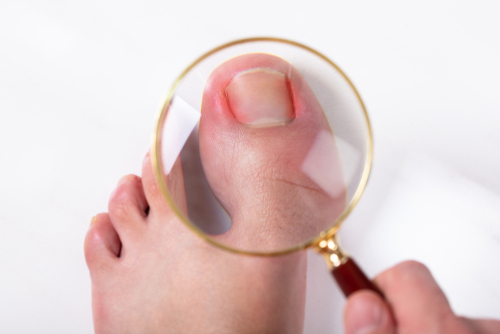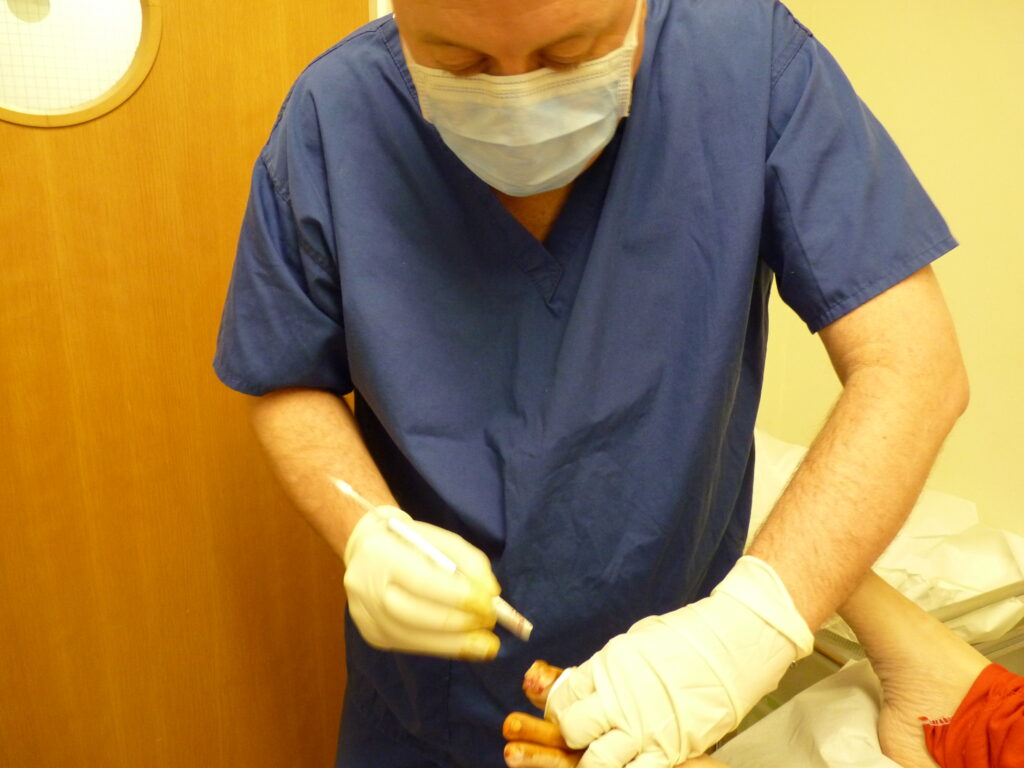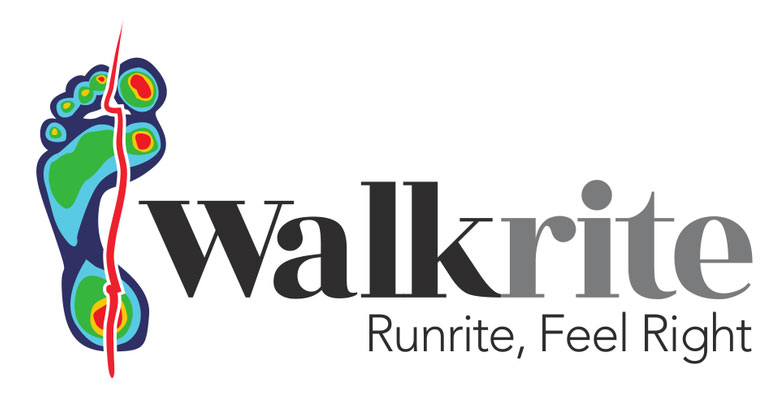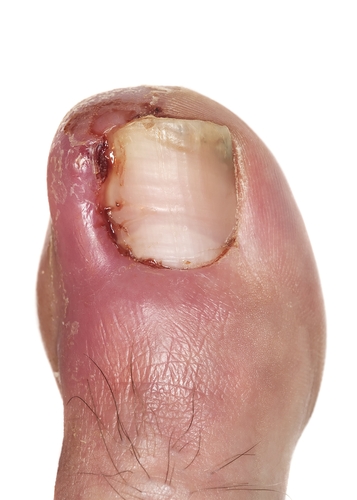
Ingrowing toenails (onychocryptosis or unguis incarnates) is caused by the edge of the nail impinging or piercing the surrounding skin. Research suggests that 80% of ingrowing toenail cases occur on the big toe (6). The pressure on or puncture to the skin can become painful and, in some cases, can lead to a secondary bacterial infection as micro-organisms (germs) enjoy warm, moist areas and can thrive on feet.
Who is at risk?
Everybody! Ingrowing toenails are a common problem and can present at any age but occur more commonly in teenage years and / or the fifth decade of life. It is estimated that it effects between 2.5% – 5% of the population, but is thought likely to affect more people as those with mild cases often do not seek medical advice (6).
Other risk factors include:
- Trauma to the nail or abnormal nail growth
- Larger or more swollen feet
- Family history of ingrowing toenails
- Hot, sweaty feet (hyperhidrosis) which can cause the nail to split and pierce the skin
- Certain medical conditions such as Diabetes (7)
- Fungal nail infections
- Poor nail cutting techniques (3)
Prevention
- Check your feet regularly
- Wear shoes that fit correctly and are not too tight, this will reduce the pressure of the nail on the surrounding skin
- Protect your toes from trauma as this can affect the way the nail grows e.g in sports such as football
- Treat fungal infections of the skin and nails
- Cut your nails evenly, not too short and avoid biting or picking them
- See a Podiatrist for regular professional nail maintenance if you are unable to self-manage your nails
Signs and symptoms
The main symptoms are pain when wearing shoes and walking from the side of the nail where it meets the skin. The toe may become red and swollen and the skin may become infected. Common signs of an infection include heat, swelling, pain, redness, redness that is spreading over a larger area of the skin (tracking), pus and / or malodour. If you have any signs of infection, you should see a Podiatrist or your GP practice as infection can be a serious medical concern if left untreated.
Diagnosis
If you think you have an ingrowing toenail or are not sure why your toe is painful, booking an appointment with a Podiatrist is a good place to start. We will make the diagnosis and discuss the treatment options that would be suitable for you. Some conditions such as sub-ungual exostosis (bone growth from underneath the nail), some cancers and also loss of blood supply to a part of your toe (ischaemia) can present like an ingrowing toenail and it is important that these are excluded before treatment is started. If a more serious condition is suspect, Podiatrists can identify this and ensure the most appropriate onward referral.
Treatment
Self-management:
Generally ingrowing toenails worsen if left untreated (4). If the nail is not painful, infected or causing you concern you may be able to self-manage by:
- Wearing shoes that fit correctly and are not too tight. This may reduce the pressure on the nail and surrounding skin and may be particularly important in sports shoes
- Protecting your nails from trauma by wearing appropriate footwear, especially if you are unable to feel your feet (peripheral neuropathy such as in Diabetes)
- Treating fungal infections of the nail and skin as they can change the colour, shape and thickness of your nails
- Wearing clean and natural fibre socks which may help regulate the temperature and bacterial load on your feet
- Cutting your nails evenly without sharp corners and not too far down the sides

Treatments provided in clinic:
Our treatments our guided by current, good quality research and best practice. During your first appointment, we will assess and explain the options available to you along with the treatments, procedures, risks and benefits, prior to booking you in for further treatment:
- Nail reduction – this is where we cut back the side of the nail that is pressing on the skin. This can be done in clinic without anaesthetic but, if too painful, a local anaesthetic will be required. Reducing the nail can be effective and lead to long-term self-management. For more severe cases, this approach may not be effective and nail surgery to fully remove part or all of the nail may be the most suitable option
- Nail reduction or resection under local anaesthetic without ablation of the nail bed – this is a minor surgical procedure performed when the nail is too painful to reduce without anaesthetic or when the nail has to be removed following trauma. Once the toe is numb, either the whole or problem part of the nail is removed. The appointment time is between 30-60 minutes and it is better if you can reduce pressure on the toe or rest afterwards for a while. The toe will need to be kept covered and clean until it has healed. During this process the nail cells have not been destroyed, so the nail will grow back. If the problem recurs, nail surgery with chemical ablation of the nail bed may be required
- Nail removal or resection with chemical ablation of the nail bed– this is the same procedure for removing the nail under local anaesthetic, however, with this process, a chemical is applied to the nail base (matrix) to destroy the nail-producing cells. Various chemicals and ways of destroying the nail cells are used, however, we use a chemical called phenol. Evidence suggests the application of phenol is the most effective for this purpose and significantly reduces the likelihood of the nail growing back (4,5). Having a chemical applied to the nail matrix means it takes longer to heal. We would expect full healing within 6 weeks. No pain is felt during the surgery and, after the first 24 hours, normal activity can be resumed unless the toe is too sensitive. The wound is checked in clinic at 3 days, 2 weeks later and then 4 weeks after that to ensure complete healing. Once healed, the area of the nail bed that has been destroyed with the chemical grows back as skin instead of nail meaning that the ingrowing toenail will not return
Other treatments
Other treatments have been advocated but they are not well-evidenced therefore we don’t currently offer them in clinic including:
- Nail bracing (orthonyxia)
- Nail splinting
- Nail elevation
Ingrowing toenail facts!
| Cutting nails straight across prevents ingrowing toenails | False! | |
| There’s no evidence to support this! Cut your nails to the shape of your toe and don’t leave sharp edges or go too far down the sides, just like you cut your fingernails | ||
| Cutting a V-shape in your nails, nail bracing or splinting prevent ingrowing toenails | False! | |
| These approached haven’t been found to be effective in treating or preventing ingrowing nails | ||
| The incidence of ingrowing toenails increased during the Covid-19 lockdowns | True! | |
| Yes, this is true. We have no good explanation for it but evidence suggests there was an increase in nail biting and picking, which was linked to the changes in our normal activities (2) and possibly led to the increase in ingrowing toenails! |
More questions about ingrowing toenails?
Please contact us if you would like more details about ingrowing toenails or the treatments that we offer for them or book here if you would like to make an appointment.
References
1. Borges, A.P.P., Pelafsky, V.P.C., Miot, L.D.B. and Miot, H.A. (2017) Quality of life with ingrown toenails: A Cross-Sectional Study. Dermatologic Surgery, 43(5), pp.751–753.
2. Carrillo-Diaz, M., Ortega-Martínez, A.R., Romero-Maroto, M. and González-Olmo, M.J. (2022) Lockdown impact on lifestyle and its association with oral parafunctional habits and bruxism in a Spanish adolescent population. International Journal of Paediatric Dentistry, 32(2), pp.185–193.
3. Cho, S.Y., Kim, Y.C. and Choi, J.W. (2018) Epidemiology and bone-related comorbidities of ingrown nail: A nationwide population-based study. The Journal of Dermatology, 45(12), pp.1418–1424.
4. Exley, V., Jones, K., O’Carroll, G., Watson, J. and Backhouse, M. (2023) A systematic review and meta-analysis of randomised controlled trials on surgical treatments for ingrown toenails part I: recurrence and relief of symptoms. [online] https://jfootankleres.biomedcentral.com/articles/10.1186/s13047-023-00631-1. Available at: https://doi.org/10.1186/s13047-023000631-1%20REVIEW%20(2023).
5. Exley, V., Jones, K., O’Carroll, G., Watson, J. and Backhouse, M. (2023) A systematic review and meta-analysis of randomised controlled trials on surgical treatments for ingrown toenails part I: recurrence and relief of symptoms. [online] https://jfootankleres.biomedcentral.com/articles/10.1186/s13047-023-00631-1. Available at: https://doi.org/10.1186/s13047-023-00631-1%20REVIEW%20(2023).
6. Ibrahim, A., Seher, B., Pelin, K. and Deniz, A. (2019) Clinical and sociodemographic characteristics of patients with ingrown nails. Journal of the American Podiatric Medical Association, 109(3), pp.201–206.
7. Vural, S., Bostanci, S., Koçyigit, P., Çaliskan, D., Baskal, N. and Aydin, N. (2018) Risk factors and frequency of ingrown nails in adult diabetic patients. The Journal of Foot and Ankle Surgery, 57(2), pp.289–295.

